Good morning! It’s the end of the week, and that means you can stop by Friday Feedback to get help with a work in progress. It also means another great mini-lesson, and today’s guest author is Linda Urban!
Linda writes picture books, chapter books, and middle grade novels. Her titles include A Crooked Kind of Perfect, Hound Dog True, The Center of Everything, Milo Speck Accidental Agent, Mouse Was Mad, Little Red Henry, Mabel and Sam at Home, Weekends with Max and His Dad, and Road Trip with Max and His Mom. Her books have appeared on more than 25 state reading lists, as well as best books lists from The New York Public Library, Kirkus, the National Council of Teachers of English, and IndieNext. Linda has a BA in Journalism and an MA in English from Wayne State University in Detroit and pursued further graduate study in Film and Television Critical Studies at UCLA. For ten years, she served as marketing director at Vroman’s Bookstore in Pasadena, California.
Linda’s joining us today to talk about notebooks!
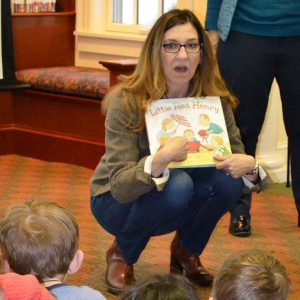
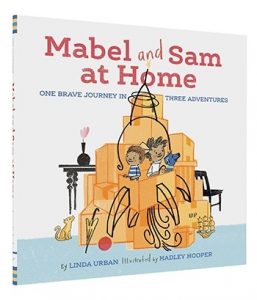
One of the most important things I’ve ever written is this:
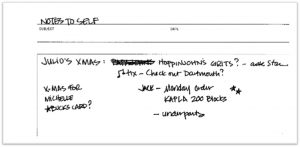
Like so many people who love to read and aspire to write, I had been gifted dozens of beautiful notebooks over the years. Hardcover, softcover, leather bound, handmade. I’d purchased at least as many for myself. And I almost never wrote in them. I was so afraid of making a mistake, or saying something inane, or making any mark I thought might be unworthy of the paper I was writing on.
The notebook page you see above was one such journal. Hardcover. Thick paper. Bright white. I loved it and knew instantly that THIS would be the journal of all journals – a document of our family’s holiday traditions, the sort of thing that my children would find upon my death and sue each other for custody of, it was so poignant and lyrical and full of meaning. On the first page, I hoped to begin with something simple. A Christmas shopping list. For my husband’s first gift, I intended to purchase a Southern treat I knew he’d love. These special, mail-order only grits from a company called Hoppinjohn’s. Do you see what I wrote instead? Yes. Papa Johns.
So long perfect notebook!
Or maybe, hello perfect notebook.
Because for the first time ever, I crossed out my mistake and kept writing. The burden of heirloom writing had been lifted and now I could write ANYTHING!
In an instant, my notebook went from being a performance space, with the expectation of perfection and a someday-audience, to a practice space where experimentation, play, and messes were not only okay, but expected.
And it has made a huge difference in my work. My notebooks are full of observations, experimentations, doodles and drafts. Jumbled amongst the writerly stuff are to do lists, drawings by my kids, theater programs, and recipes. And while that might sometimes make a particular item a tiny bit more challenging to retrieve a few weeks later, most of the time it prevents me from feeling too precious about things.
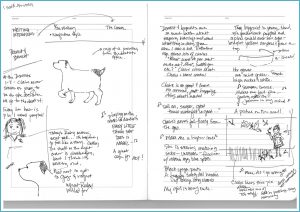
This is a page of observations from a trip to the dentist’s office. While I have not written a novel set in a waiting room, I can’t say it won’t happen. And the practice of observing small details has most definitely come in handy.
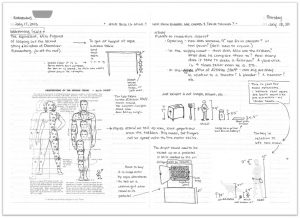
This is a notebook page I made during a revision of Milo Speck, Accidental Agent. I was working out the relative size of our hero, Milo, to the beings and features of Ogregon. These doodles didn’t just help with revising what was already in the manuscript, it sparked inspiration for an entirely new scene.
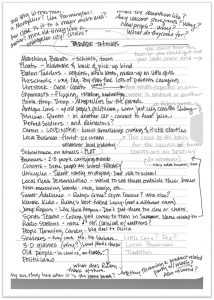
This is a brainstormed list of participants one might find in a small town parade, like the Bunning Day Parade that structures so much of The Center of Everything. You see I’m also working out some of the book’s themes and character choices as well.
Since messing around with my own notebook, I’ve grown more and more interested in the ways that other creative people use notebooks and if you’re similarly intrigued, I highly recommend you take a look at Syllabus by cartoonist and University of Wisconsin Prof Lynda Barry (whose Tumblr is a must-follow). Also eye-opening, the notebook Frances Ford Coppola kept while working on The Godfather (scroll down to see the actual pages. That is annotation!), and this great collection of notebook pages from JK Rowling, Kurt Cobain, and Sylvia Plath, whose sketches of the furniture at Yaddo are both delightfully wonky and a model for keen observation.
Your Assignment: More important than studying other people’s notebooks, however, is to get busy getting messy in your own. So, my prompts for you today are twofold.
- If you have a nice notebook that you haven’t been using, take it out now. Open randomly to any page. Make a mess.
I KNOW IT IS HARD!
You’re expecting someone to scold you. Or you want to scold yourself.
Ask yourself why that is.
What principle or belief is at work?
Now set a timer and for five minutes, write about why you hold that belief. Where did it come from? What purpose does it serve? Is it empowering you – or holding you back?
Does that belief in any way inform your internal editor?
- Find another page. If you like, you can turn to the front of your notebook, but if you’re feeling really rebellious after exercise one, let randomization be your guide.
Set your timer for ten minutes and observe the space you’re in. You don’t need to write in complete sentences – in fact, it might be better if you don’t. Take time to notice. What do you hear? What sounds are closest to you? What sounds are furthest away? What sound is missing? How about touch? What temperature is it? How humid? Are you sitting? Standing? What surfaces are you making contact with? What do you see? What is just out of sight?
Turn the page. Now consider a setting from your work in progress. A protagonist’s bedroom. That awkward Thanksgiving dinner at the All-You-Can-Eat Buffet. The dragon-tamer’s office. Whatever. Now set your timer for 10 minutes and do the same sort of observing. Doodle, draw, write, draw lines and arrows.
Now set your timer for another 10 minutes and write a moment where your protagonist enters this space. Let her observe. Notice how her emotions, her agenda, her experience shape her observations. Don’t worry if what you write has little to do with your story-in-progress. This is notebook work. You’re not performing for a reader. You’re practicing. Get messy.





Linda,
Thanks so much for sharing. I have really gotten into using a notebook for my current WIP adding pictures and info I want to check on. It’s nice having it all in one place. Part of my book involves an abandoned amusement park, so I first wrote down the rides that may be there. Then I did a layout of the park and then I watched some videos on abandoned parks and went back into my notebook and added names to the rides and eating places and how they would look overgrown. I’m no artist but you don’t have be and it’s really helped with getting perspective. And it’s fun.
Thanks again for sharing.
This all sounds great, Martha. Perfect use of a notebook for a project in the works. Amusement park research sounds fun. There’s an abandoned park in one of Richard Russo’s books, too, isnn’t there? Such a sad place in his book — but such promise for all sorts of stories. Glad you’re using your notebook to puzzle this out!
Linda,
I love your advice….just get messy. I go back and forth between lined notebooks and cheap un-lined artist sketch books from Wal-mart. Someday, my grocery lists are gonna be rockin some book on the best seller list 😉 . Seriously, I love the whole permission to get messy and not write IN ORDER of the pages. Having fun and breaking my own rules is when I like my writing best.
One of my favorite notebooks is power-point, believe it or not. I make a monthly power point, starting with blank pages. It’s easy to copy & paste snippets and pics from my social media perusing into that notebook. I add comments, draft sentences and sometimes pages there. Then, at the end of the month I move that notebook from my desktop to a folder and begin a fresh power point. This helps me make my screen time part of my creative time. For example, I will be pasting a link to this post in my power point for this month. I can get back to it easy when I want to go perusing those other notebook pages you mentioned.
Amy Ludwig VanDerwater has a blog called, Sharing Our Notebooks where she highlights kid and adult writer notebooks. I rec that blog too. http://www.sharingournotebooks.amylv.com/
YOU….you keep writing! Our (as in the “greater our”) love your work and I’m so glad you keep filling notebooks and sending out beautiful books into the world.
Thanks for the interesting link! I have lots of my own notebooks and I’m fascinating by the peek into someone else’s!
I really like Amy’s blog, too. I also follow some notebook people on Tumblr. There is often real inspiration there, but I also have to be careful. If I fall for someone else’s pretty mess, I can be lured into thinking my notebook should be prettier or messier in the same way.
The best thing for me is to carry it always and think of it as a tool. The thing itself is not a product, it is a tool that helps me record, think, process, explore, etc.
I adore your idea of using PowerPoint in this way.
Thanks for the encouragement! 🙂
Thank you for addressing the paralysis so many of us feel. Where DOES that fear/guilt come from? I have struggled with notebooks and often skip the first page to help relieve the stress of not wanting to “ruin” it. Your post is so encouraging. Thank you!
I often skip the first page, too.
Sorting out where our fear and guilt comes from is not always easy work — but it is worth it. And it often brings us back to our childhoods, which is not a bad thing for those of us writing for kids.
Keep at it, Marilyn.
🙂
I would be lost without my writing notebook/journal. It has all kinds of goodies in it — doodles, bits of writing advice I’ve printed, inspiring quotes, scribbled ideas, notes about my life & my insecurities, free writing, story drafts. It’s everything.
I actually use a small spiral bound sketchbook. Not too fancy, but with nice paper. I actually have about 40 of them now! (I go through more than one book a year).
I love these exercises. What a great way to develop practice in observing!
I’m glad the exercises are useful for you!
I carry my notebooks just like you do. I don’t have games on my phone, so it is often my notebook I turn to when I’m in waiting rooms and coffee shops. Sounds like we use our notebooks similarly.
Here’s to notebook #41!
I write almost all of my first drafts long-hand, and I certainly do lots of brainstorming and planning long-hand.
I switched to buying cheap notebooks at Target or Staples for just this reason. I don’t worry about making a mess, whereas I’d always pause before messing up some leather-bound beauty. I work best with unlined pages, so I go for those when I can, but cheap and lined is still better than fancy and unlined.
I’m still keen on lines — maybe I need just a smidge of order in my life? Or the small boundaries actually give me room to play in? Who knows? I’m glad you’ve found what works for you, Michelle. Keep writing, kid.
This rings true for me! I used to “write” on the right side of a notebook and give myself permission to doodle and wander on the left side. Of course, I ended up writing the real stuff on the left, but the division gave me the permission I needed to be creative!
Great strategy!
But what is this “used to”? Have you changed strategies?
Do not tell me you’ve given up on your notebooks!
I have a bed stand full of half-filled journals that also slide into my purse. A couple thoughts:
A writing teacher a long time ago encouraged writing on just one side so that you can revise using blank space on the opposite side — and a different color ink. That’s worked well for me.
I definitely like the idea of random beginnings. I’ll often leave a couple of blank pages when I begin a new passage. Just figuring out now that strategy doesn’t really work for me because it has more to do with my overthinking structure than allowing expansive revision space.
I love the idea of writing on one side and using the other for revising in a different color. I’ve never tried that, but I think that I will try out that idea! Thank you for sharing it!
Very interesting!
I like the idea of leaving room for revision if that is the sort of job you want your notebook to do.
Most of the time, i don’t return to the things in my notebooks. They are used more like designer Michael Beirut uses his (see this Design Observer post: https://designobserver.com/feature/26-years-85-notebooks/6067 ) as a place to collect and process, but not necessarily to refer to later.
Love thinking of that pile of notebooks on the bedside table . . .
Linda, I absolutely loved this exercise. I have been researching writers’ notebooks and am so pleased to have this mini=lesson in my toolkit. In exploring my assumptions, I wrote how I felt that writers I learned about in school were no longer living and often belonged to elite intellectual circles. I feel like my own students may still feel this way as many schools often push the “cannon”. This lesson, paired with actual photos of real writers notebook will hopefully inspire some of my students to understand that the process of writing can be messy and that is ok. I am incredibly inspired by this work you shared today. Thank you very much!
I’m so glad it was useful to you.
I love talking with students about notebooks — and leading messy exercises that include doodling and mapping and lots of mess.
And I get what you’re saying about a canon. When I was a kid, I thought that all the books were already written and all the authors were dead. Except Judy Blume — but even then I didn’t feel like she was quite real.
Will you be at NCTE? I’m on a panel with Michelle Haseltine we’ll be talking notebooks for a full hour. Plenty of slides, too, I suspect.
Keep up your good work!
Hi Linda,
THANK YOU for the mini-lesson on writer’s notebooks. I LOVED your examples.
Three years ago, I taught an after school class on writer’s notebooks. The kids had to sign up and pay a small fee, so there were only eight kids in class (a dream – considering I’m used to 26 kids in ELA class). The first thing that I did was give them a composition notebook and a bunch of art supplies to decorate their notebook (however they wanted – no specifications). Then, we went to work with our writing. We all wrote together, and we all shared (if we felt comfortable – all eight felt comfortable). Three of the students that took that class are still writing in their notebooks. All three of them have new notebooks (two of them filled the one that we decorated). I was in awe of this, but the experience helped me to understand the power of the writer’s notebook.
As always, thank you for the inspiration. My past class loved Hound Dog True – as always, it sparked such wonderful conversations about friendship, story telling, and (this year) love. My new class will be reading it in the winter.:)
How lucky are those kids? And what a wonderful gift you gave them. I wish all kids could have that experience.
Thanks again for the kind words about Hound Dog True. Let’s talk this winter, okay?
ABSOLUTELY! My kids would love it. My librarian would love it. I would love it. Hopefully, we can make something work.:) Keep writing and I’ll keep getting your words into student hands.
Andy,
What a great teacher you are! I taught a small workshop for my church group on journaling, but this is a great idea to extend it with writing.
Thank you for such a wonderful exercise!
For a long time, I hoarded notebooks because they were too nice to write in. I also was afraid that I would sully those pages with words and images that were meaningless. I feared turning those pristine pages into something messy. I wanted to save those pages for something meaningful, but I had a hard time determining exactly what that meant. I’m not sure what finally caused me to pick up one of my “nice” notebooks. I think that I realized that I had to be open to the messiness of the writing process and that meant embracing instead of fearing those blank pages. Before I knew it, I had one notebook filled with ideas, observations, and snippets of projects. Since that revelation, I’ve continued to fill notebooks freely and I’ve never looked back.
I know exactly what you mean!
I still have fancy notebooks like that, by the way. They sit on a pretty shelf being pretty. The difference between a china doll and that mangled stuffed lamb you carted everywhere when you were a kid. One was an object, the other gathered all the stuff of life and in the process acquired its own kind of aliveness.
Thanks for sharing this, Jen.
Linda,
I love this post and exercise! I have a love with journals and notebooks. Thank you for the links; I will check them out. I purchased When Wanderers Cease to Roam: A Traveler’s Journal of Staying Put by Vivian Swift just to look at her pictures. I like writing and drawing or doodling. I have also looked at several other authors’ journals. Last year I read Anthony Doerr’s Four Seasons in Rome where he journals his four seasons in Rome while on a prestigious writing sabbatical which he was awarded. Another book I like is Hannah Hinchman’s A Life in Hand: Creating the Illuminated Journal. So, maybe your children will publish your observations some day! Thanks again.
Kate Messner has strict instructions. Upon news of my death, she will drive to my house, gather my notebooks and burn them. Or at least, tear out all the grumpy pages before anyone else gets to see them.
I love the Hinchman book, too, Kay. So beautiful.
Linda,
I enjoyed making a mess in my notebook and this is definitely something I will continue. This was a very valuable writing exercise for me! I sat outside for 10 minutes recording everything I saw, heard and felt around me. Doing this afforded me the opportunity to stop, listen and really pay close attention to my surroundings, something I don’t do often enough. I am not currently writing a story, but I did this activity again using a concert hall as the setting. I enjoy going to the orchestra on occasion, so it was easy to fill the page with drawings, captions and writing about this setting. Then I thought about how this setting might be viewed by someone who enjoys concerts and someone who doesn’t and might have been dragged there unwillingly. The same setting yet two contradictory views of it.
I started a notebook a few years ago and paste in articles (mostly editorials) that resonated with me. I also write some quotes in there or something that really inspired or struck me. I’m glad I started it because I can go back to it anytime.
Thanks for being a part of Teachers Write. I can’t wait to keep my notebook going–and not be afraid of making a mess (that’s very hard for me, by the way:)
Jane 🙂